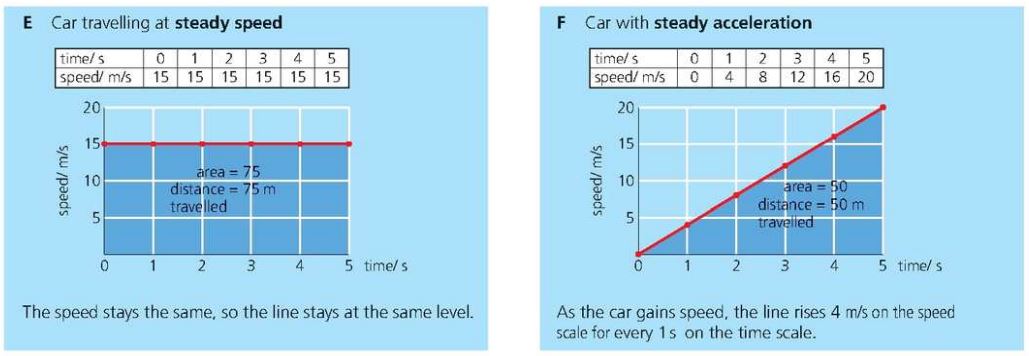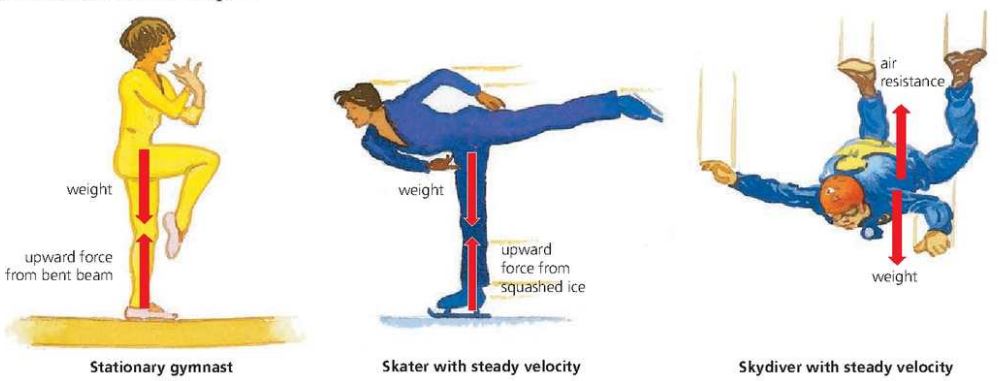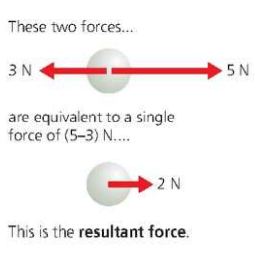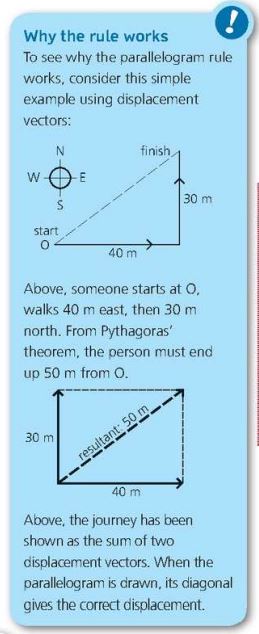Chapter 2: Forces and Motion
Speed, Velocity and Acceleration
Speed
- It is a ==scalar quantity,== that is the ==measure of rate of change of distance.==
- Formula:
- Speed: Distance moved/Time taken
Velocity
- It means the ==speed of something== and its ==direction of travel.==
- It shows direction and magnitude so its a vector.
Acceleration
Something is ==accelerating if its velocity is changing.==
Formula:

- “u” is the initial velocity and “v” is the final velocity.
It is a vector.
A negative acceleration is called deceleration or retardation.
A uniform acceleration means a constant (steady) acceleration.
Motion Graphs
Distance-time graphs
- On a ==distance time graph, the gradient of the line is numerically equal to the speed.==
- Gradient of distance time graph is speed.
- Following are examples of common distance time graphs:
Speed-time graphs
- On a speed time graph, ==the gradient of the line is numerically equal to acceleration.==
- The ==area under the line is numerically equal to the distance travelled.==
- Following are common examples of speed time graphs:
 Free Fall
Free Fall
The acceleration of free fall, g
- ^^Gravitational field is a region where a mass will experience a non-contact gravitational force.^^ ==All matter produces a gravitational field around it, and the greater its mass, the stronger the field.==
- Acceleration of free fall is 10m/s^2.
- Formula for measuring ‘g’:

- "h” is the height, “t” is the time taken.
Motion Graphs

- If acceleration is not steady then it is non-uniform.
Forces in balance
- A force is a ==push or a pull, exerted by a object.==
- It has ==direction as well as magnitude, so its a vector.==
- SI unit of force is Newton (N).
- Force ==can be measured using a spring balance.==
- The more its stretched, higher the reading on the scale.
Common forces
- Upthrust is the ==upward force from a liquid or gas that makes things float.==
- Weight is the ==gravitational force on an object.==
- Tension is the ==force in a stretched material.==
- Friction is the ==force that opposes the motion of one material sliding past each another.==
- Thrust is the ==forward force.==
- Air Resistance is another type of friction.
Newton’s Law
- First Law ==states that every object will continue in its state of rest or uniform motion in a straight line unless a resultant force acts on it.==
- For example, shaking a tree.
- Second Law ==states that when a resultant force acts on an object of a constant mass, the object will accelerate in the direction of the resultant force.== The ^^product of the mass and acceleration of the object gives the resultant force.^^
- It can symbolized as:
- F = ma
- For example, pushing a cart.
- Third law ==states that every action there is an equal but opposite reaction.==
- For example, If object A exerts a force on object B, then object B will exert an equal but opposite force on object A.
Motion without Force
- ==If no external force is acting on it, an object will==
- If stationery, remain stationery,
- If moving, keep moving at a steady speed in straight line.
- NOTE: this is newton’s second law.
Balanced Forces
An object may have several forces on it. But ==if the forces are in balance, they cancel out each other. Then, the object behaves as if there is no force on it.==
Following are a few examples:

==With balanced forces on it, an object is either at rest, or moving at a velocity.==
- This is newton’s first law.
Force, mass and acceleration
Inertia
- ==Resistance to change in velocity is== ==inertia.==
- For example,
- when an object is at rest it is given a force to move, its velocity at rest was 0 m/s^2 and now when its given a force to move, velocity has increased.
- also, when an object is moving its velocity is 5 m/s^2 and when a force is given to slow it down or make it move it fast, there is a change in velocity.
Resultant Force
==When two forces are unbalanced. They are equivalent to a single force. This is called== ==Resultant Force.==
For example,

Friction
- ==It is a force that tries to stop materials sliding across each other.==
- It prevents machinery from moving freely and heats up its moving parts.
- Example,
- when you rub your hands,
- between car wheels and road.
- Ways to reduce friction,
- use ball bearings,
- oil or grease to make the moving surfaces slippery
- Kinds of friction
- %%static%% %%- defined as the frictional force that acts between the surfaces when they are at rest with respect to each other.%%
- %%dynamic%% %%- defined as the opposing force that comes into play when one body is actually moving over the surface of another body.%%
Force, Weight, and Gravity
Gravitational Force
- It is the %%downward pull%% from Earth
- Some of the main features:
- all masses attract each other.
- the greater the masses, the stronger the force.
- the closer the masses, the stronger the force.
Gravitational field strength, g
It is a ==region in which a mass experience a force due to gravitational attraction.==
Earth’s gravitational field strength is 10 newtons per kilogram. (N/kg)
 NOTE:
NOTE:‘g’ has two meanings:
- g is the gravitational field strength (10 newtons per kg)
- g is the acceleration of free fall (10 meters per second^2)
Momentum
It is the ==quantity of motion of a moving body, measured as a product of its mass and velocity.==

Linking force and momentum: Newton’s second law
Linked with the following equation:

Resultant force = rate of change of momentum.
==The link between a resultant force and the rate of change of momentum it produces is== Newton’s second law of motion.
Impulse
- ==The ‘quantity force x time’ is impulse.==
- ==Newton noted that when the same force acted for the same time on different masses, a large mass would gain less velocity than a smaller one, but the change in 'mass x velocity' was the same in every case.==
- ==When two or more objects objects act on each other, their total momentum remains constant, provided no external forces are acting.==
- Moving objects have kinetic energy. In a collision, some of that energy can be changed into other forms.
- %%If a collision is elastic, the total kinetic energy of the moving objects is the same after the collision as before.%%
- {{However, most collisions are not like this. The total kinetic energy is less after the collision than before. In such cases, the 'missing' energy is changed into heat (thermal energy).{{
Vectors
- ==Quantities which have direction as well as magnitude, are== ==vectors.==
- Eg. Force, Velocity, Acceleration and others.
- ==Two vectors acting at a point can be replaced by a single vector with the same effect, is its== ==resultant.==
- Quantities which have magnitude but no direction, are scalar.
- Eg. Mass, Length, Distance and others.
Adding Vectors: Parallelogram rule
==The parallelogram rule is a== ==method of finding the resultant== ==in situations like the one above, where the vectors are not in line. It works like this:==
^^Q: To find the resultant of two vectors (for example, forces of 30 N and 40 N acting at a point O, as in the diagram below):^^

On paper, draw two lines from 0 to represent the vectors. The directions must be accurate, and the length of each line must be in proportion to the magnitude of each vector.
Draw in two more lines to complete a parallelogram.
Draw in the diagonal from O and measure its length. The diagonal represents the resultant in both magnitude and direction. (Below, for example, the resultant is a force of 60 N at 26° to the horizontal.)

Note:

Moving in Circles:
Centripetal Forces:
- ==Inward force needed to make an object move in a circle is called the== ==centripetal force.==
- More centripetal force is needed if:
- the mass of the object is increased
- the speed of the object is increased
- the radius of the circle is reduced.
Orbits:
- Satellites around the Earth
- Planets around the sun
- Electrons around the nucleus